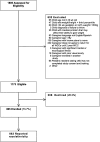Racial and ethnic differences associated with feeding- and activity-related behaviors in infants
- PMID: 24639273
- PMCID: PMC3966498
- DOI: 10.1542/peds.2013-1326
Racial and ethnic differences associated with feeding- and activity-related behaviors in infants
Abstract
Objective: To examine parental reports of feeding and activity behaviors in a cohort of parents of 2-month-olds and how they differ by race/ethnicity.
Methods: Parents participating in Greenlight, a cluster, randomized trial of obesity prevention at 4 health centers, were queried at enrollment about feeding and activity behaviors thought to increase obesity risk. Unadjusted associations between race/ethnicity and the outcomes of interest were performed by using Pearson χ(2) and Kruskal-Wallis tests. Adjusted analyses were performed by using proportional odds logistic regressions.
Results: Eight hundred sixty-three parents (50% Hispanic, 27% black, 18% white; 86% Medicaid) were enrolled. Exclusive formula feeding was more than twice as common (45%) as exclusive breastfeeding (19%); 12% had already introduced solid food; 43% put infants to bed with bottles; 23% propped bottles; 20% always fed when the infant cried; 38% always tried to get children to finish milk; 90% were exposed to television (mean, 346 minutes/day); 50% reported active television watching (mean, 25 minutes/day); and 66% did not meet "tummy time" recommendations. Compared with white parents, black parents were more likely to put children to bed with a bottle (adjusted odds ratio [aOR] = 1.97, P < .004; bottle propping, aOR = 3.1, P < .001), and report more television watching (aOR = 1.6, P = .034). Hispanic parents were more likely than white parents to encourage children to finish feeding (aOR = 1.9, P = .007), bottle propping (aOR = 2.5, P = .009), and report less tummy time (aOR = 0.6, P = .037).
Conclusions: Behaviors thought to relate to later obesity were highly prevalent in this large, diverse sample and varied by race/ethnicity, suggesting the importance of early and culturally-adapted interventions.
Trial registration: ClinicalTrials.gov NCT01040897.
Keywords: breastfeeding; feeding; infants; obesity; parenting; physical activity; television.
Figures
References
-
- Leunissen RW, Kerkhof GF, Stijnen T, Hokken-Koelega A. Timing and tempo of first-year rapid growth in relation to cardiovascular and metabolic risk profile in early adulthood. JAMA. 2009;301(21):2234–2242 - PubMed
-
- Taveras EM, Rifas-Shiman SL, Sherry B, et al. . Crossing growth percentiles in infancy and risk of obesity in childhood. Arch Pediatr Adolesc Med. 2011;165(11):993–998 - PubMed
Publication types
MeSH terms
Associated data
Grants and funding
LinkOut - more resources
Full Text Sources
Other Literature Sources
Medical


